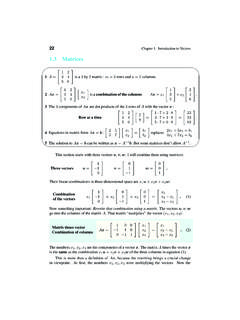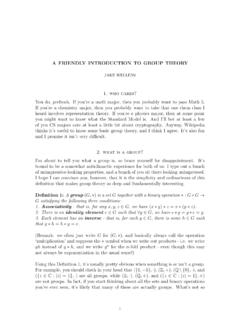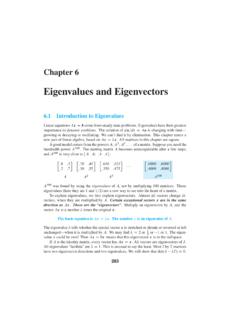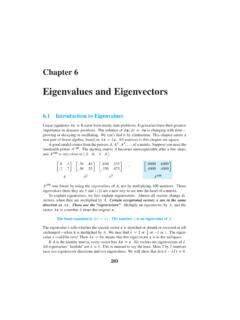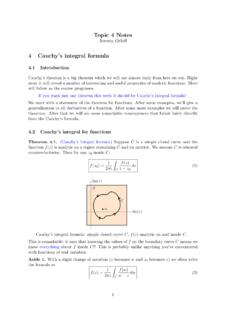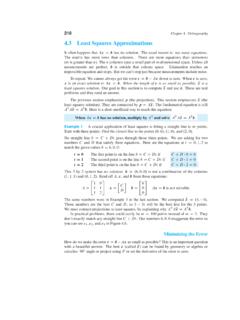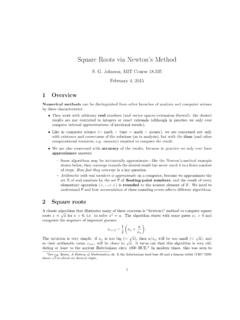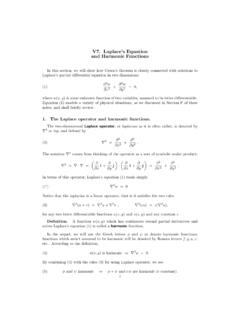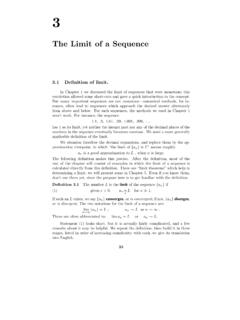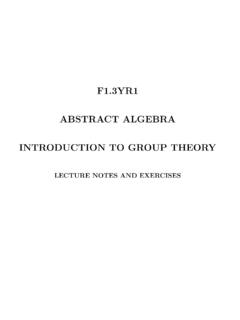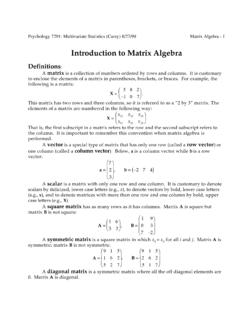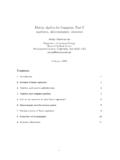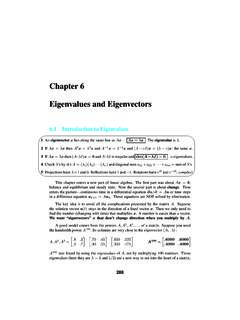Transcription of Introduction to Linear Algebra, 5th Edition
1 22 Chapter 1. Introduction to Matrices'&$%1A= 1 23 45 6 is a3by2matrix :m= 3rows andn= 1 23 45 6 x1x2 is acombination of the columnsAx=x1 135 +x2 246 .3 The3components ofAxare dot products of the3rows ofAwith the vectorx:Row at a time 1 23 45 6 78 = 1 7 + 2 83 7 + 4 85 7 + 6 8 = 235383 .4 Equations in matrix formAx=b: 2 53 7 x1x2 = b1b2 replaces2x1+ 5x2=b13x1+ 7x2= solution toAx=bcan be written asx=A 1b. But some matrices don t allowA section starts with three vectorsu,v,w. I will combine them vectorsu= 1 10 v= 01 1 w= 001 .Their Linear combinations in three-dimensional space arex1u+x2v+x3w:Combinationof the vectorsx1 1 10 +x2 01 1 +x3 001 = x1x2 x1x3 x2.
2 (1)Now something important:Rewrite that combination using a matrix . The vectorsu,v,wgo into the columns of the matrixA. That matrix multiplies the vector(x1, x2, x3) : matrix times vectorCombination of columnsAx= 1 0 0 1 1 00 1 1 x1x2x3 = x1x2 x1x3 x2 .(2)The numbersx1, x2, x3are the components of a vectorx. The matrixAtimes the vectorxis thesameas the combinationx1u+x2v+x3wof the three columns in equation (1).This is more than a definition ofAx, because the rewriting brings a crucial changein viewpoint. At first, the numbersx1, x2, x3were multiplying the vectors. Now Matrices23matrix is multiplying those matrixAacts on the vectorx.
3 The outputAxis acombinationbof the columns see that action, I will writeb1, b2, b3for the components ofAx:Ax= 1 0 0 1 1 00 1 1 x1x2x3 = x1x2 x1x3 x2 = b1b2b3 =b.(3)The input isxand the output isb=Ax. ThisAis a difference matrix becausebcontains differences of the input vectorx. The top difference isx1 x0=x1 is an example to show differences ofx= (1,4,9): squares inx, odd numbers 149 =squaresAx= 1 04 19 4 = 135 =b.(4)That pattern would continue for a4by4difference matrix . The next square would bex4= 16. The next difference would bex4 x3= 16 9 = 7(the next odd number).The matrix finds all the differences1,3,5,7at Note: Multiplication a row at a may already have learned aboutmultiplyingAx, a matrix times a vector.
4 Probably it was explained differently, using therows instead of the columns. The usual way takes the dot product of each row withx:Axis alsodot productswith rowsAx= 1 0 0 1 1 00 1 1 x1x2x3 = (1,0,0) (x1, x2, x3)( 1,1,0) (x1, x2, x3)(0, 1,1) (x1, x2, x3) .(5)Those dot products are the samex1andx2 x1andx3 x2that we wrote in equation (3).The new way is to work withAxa column at a time. Linear combinations are the key tolinear algebra , and the outputAxis a Linear combination of numbers, you can multiplyAxby rows. With letters, columns are the good 2 will repeat these rules of matrix multiplication,and explain the EquationsOne more change in viewpoint is crucial.
5 Up to now, the numbersx1, x2, x3were right hand sidebwas not known. We found that vector of differences by we think ofbas known and we look question: Compute the Linear combinationx1u+x2v+x3wto question: Which combination ofu,v,wproduces a particular vectorb?This is theinverse problem to find the inputxthat gives the desired outputb= have seen this before, as a system of Linear equations forx1, x2, x3. The right handsides of the equations areb1, b2, b3. I will now solve that systemAx=bto findx1, x2, x3:24 Chapter 1. Introduction to VectorsEquationsAx=bx1=b1 x1+x2=b2 x2+x3=b3 Solutionx=A 1bx1=b1x2=b1+b2x3=b1+b2+b3.(6)Let me admit right away most Linear systems are not so easy tosolve.
6 In this example,the first equation decidedx1=b1. Then the second equation producedx2=b1+ equations can be solved in order(top to bottom)becauseAis a triangular at two specific choices0,0,0and1,3,5of the right sidesb1, b2, b3:b= 000 givesx= 000 b= 135 givesx= 11 + 31 + 3 + 5 = 149 .The first solution (all zeros) is more important than it looks. In words:If the output isb=0,then the input must bex=0. That statement is true for this matrixA. It is not truefor all matrices. Our second example will show (for a different matrixC) how we can haveCx=0whenC6= 0andx6= matrixAis invertible . Frombwe can recoverx. We writexasA Inverse MatrixLet me repeat the solutionxin equation (6).
7 A sum matrix will appear!Ax=bis solved by x1x2x3 = b1b1+b2b1+b2+b3 = 1 0 01 1 01 1 1 b1b2b3 .(7)If the differences of thex s are theb s, the sums of theb s are thex s. That was true forthe odd numbersb= (1,3,5)and the squaresx= (1,4,9). It is true for all sum matrix in equation(7)is the inverseA 1of the difference : The differences ofx= (1,2,3)areb= (1,1,1). Sob=Axandx=A 1b:Ax= 1 0 0 1 1 00 1 1 123 = 111 A 1b= 1 0 01 1 01 1 1 111 = 123 Equation (7) for the solution vectorx= (x1, x2, x3)tells us two important everybthere is one solution toAx= matrixA 1producesx=A next chapters ask about other equationsAx=b.
8 Is there a solution? How to find it?Note on calculus. Let me connect these special matrices to calculus. The vectorxchangesto a functionx(t). The differencesAxbecome thederivativedx/dt=b(t). In theinverse direction, the sumsA 1bbecome theintegralofb(t).Sums of differences are likeintegrals of Matrices25 The Fundamental Theorem of Calculus says :integration is the inverse of 1bdxdt=bandx(t) =Zt0b dt.(8)The differences of squares0,1,4,9are odd numbers1,3,5. The derivative ofx(t) =t2is2t. A perfect analogy would have produced the even numbersb= 2,4,6at timest= 1,2,3. But differences are not the same as derivatives, and our matrixAproduces not2tbut2t 1:Backwardx(t) x(t 1) =t2 (t 1)2=t2 (t2 2t+ 1) = 2t 1.
9 (9)The Problem Set will follow up to show that forward differences produce2t+ best choice (not always seen in calculus courses) is acentered differencethat usesx(t+ 1) x(t 1). Divide that xby the distance tfromt 1tot+ 1, which is2:Centered difference ofx(t) =t2(t+ 1)2 (t 1)22= 2texactly.(10)Difference matrices are great. Centered is the best. Our second example isnot DifferencesThis example keeps the same columnsuandvbut changeswto a new vectorw :Second exampleu= 1 10 v= 01 1 w = 101 .Now the Linear combinations ofu,v,w lead to acyclic difference matrixC:CyclicCx= 1 0 1 1 1 00 1 1 x1x2x3 = x1 x3x2 x1x3 x2 =b.
10 (11)This matrixCis not triangular. It is not so simple to solve forxwhen we are it is impossible to findthesolution toCx=b, because the three equations eitherhaveinfinitely many solutions(sometimes) or elseno solution(usually) :Cx=0 Infinitelymanyx x1 x3x2 x1x3 x2 = 000 is solved by all vectors x1x2x3 = ccc .(12)Every constant vector likex= (3,3,3)has zero differences when we go cyclically. Theundetermined constantcis exactly like the+Cthat we add to integrals. The cyclic dif-ferences cycle around tox1 x3in the first component, instead of starting fromx0= 1. Introduction to VectorsThe more likely possibility forCx=bisno solutionxat all:Cx=b x1 x3x2 x1x3 x2 = 135 Left sides add to0 Right sides add to9No solutionx1, x2, x3(13)Look at this example geometrically.
